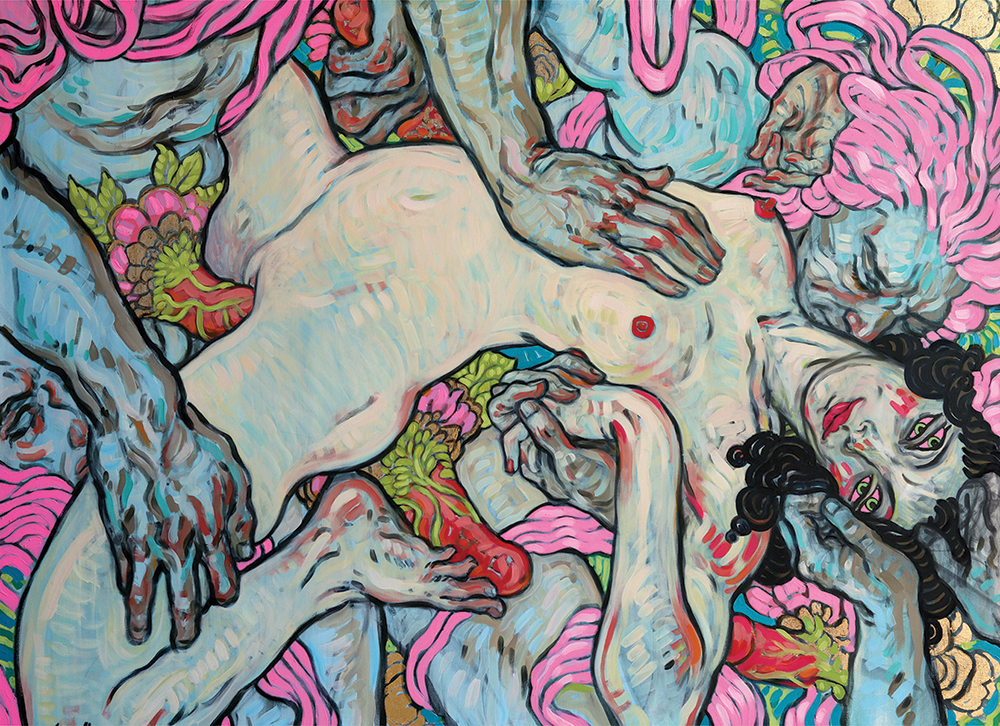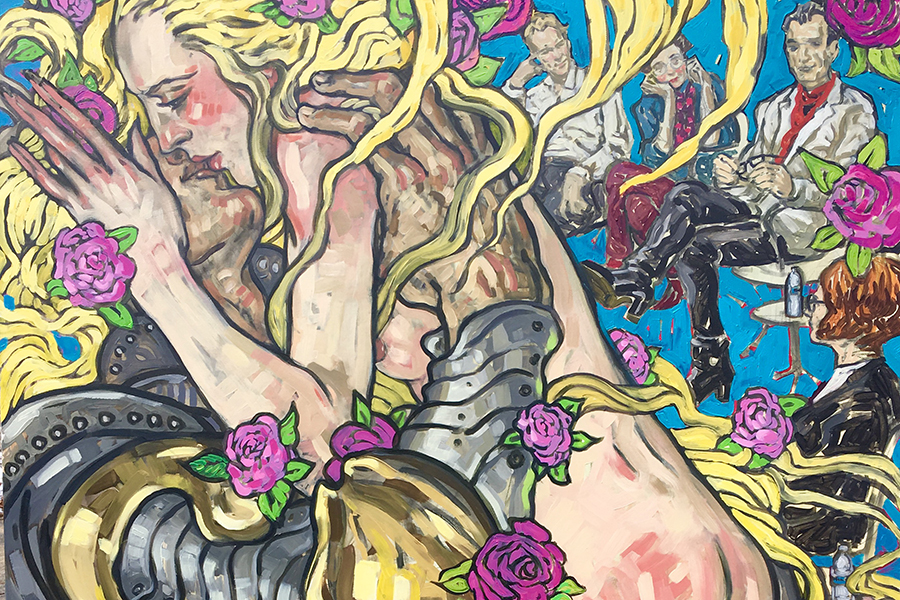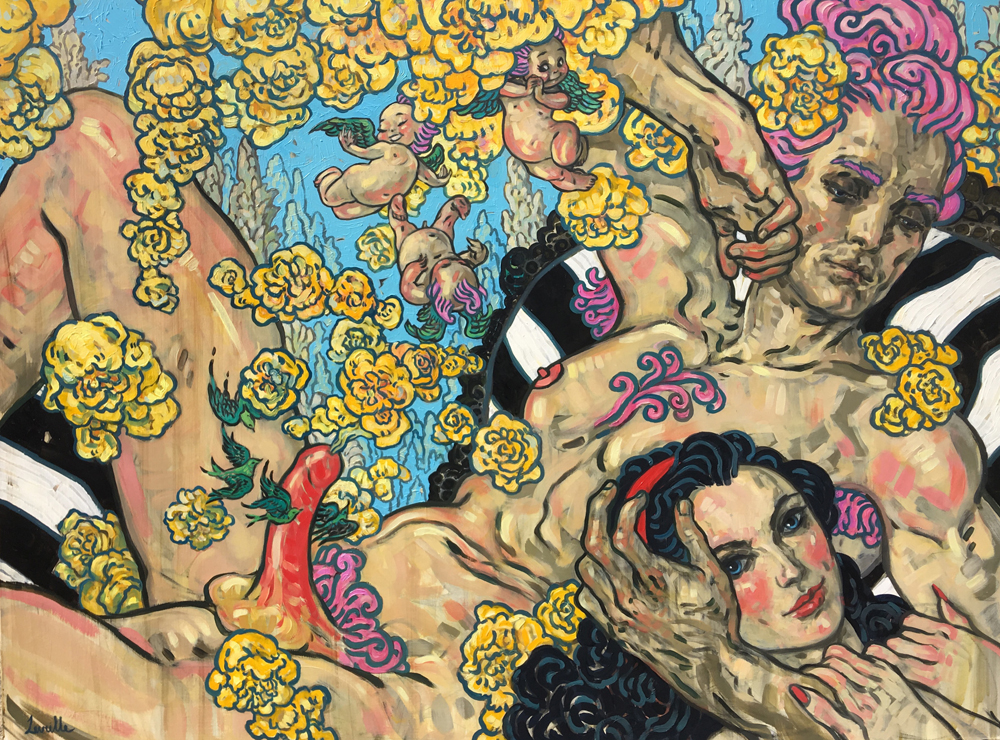
The End of Love: A Solo Show of Works by Rebecca Leveille
Opening Reception: May 1st, 6pm – 8pm
On View: May 2nd – May 19th, 11am – 6pm daily
The Untitled Space: 45 Lispenard Street, Unit 1W, New York City
The Untitled Space will be presenting “The End of Love,” a solo exhibition of works by Rebecca Leveille opening on May 1st and on view to the public from May 2nd to *May 19th (*extended dates) in New York City. Working in a figurative mode and freely mining both art historical sources and contemporary painting, Leveille cites influences ranging from Titian to Walter Robinson, Fragonard to Kara Walker. We spoke to the accomplished painter and former illustrator about her practice and the inspiration behind “The End of Love.”

Untitled: In your artist’s statement (scroll down to view), you discuss cultural ideals being built upon faulty and diseased foundations reinforced by society and pop culture. To what extent, if at all, did the current state of politics influence the work you created for “The End of Love”?
Rebecca Leveille: I’m not sure there are many people working right now that are unaffected by the political climate. In the past, I have often dealt very directly with issues like sexual assault, the boiling feelings about the treatment of woman within society and the abusive stereotypes that women exist with and in many case are a product of, as we grew up with those [stereotypes] as influences.
“The End Of Love” bears these concepts as an undercurrent, but deals more openly with the importance of a female perspective. In this work I find myself leaning into my abilities with figure, form and narrative rather shying away from them. Jerry Saltz once commented on one of my pieces and said, “zero in, eliminate narrative,” encouraging me to, as I read it, remove my internal mythologies and narratives. The power of influence is something we must all be aware of as artists, what to take what to leave is always a force.
I love stories, imagination, big emotions and romanticism. I thrive on them as a human being . Leaning into the things that are unique to me as an artist is why I work. I can draw figures from any angle in any environment, largely without models. I can create in this way very fluidly, and I love to do it. Juxtaposition of imagination and reality is essential for me, and that’s something I delight in with “The Panel Discussion (The Lovers).” My internal world reflected in the paintings is a new mythology, my own mythology.

Does anyone in particular inspire the female figures you represent in your paintings?
I think of my figures as a vocabulary—words in a language I’m trying to create in the work. I draw a great deal from my head and leap from either people I know, I see in pop culture, those around me or mythical icons, archetypes, etcetera. The women (and men) are a “dialogue” in a similar way to artists who create figurative work with an element of narrative, from Minter to Yuskavage to Currin, to create their own “types “ that feed the idea of the work.
Which piece in the show are you most excited about and why?
Always hard to pick a favorite. Each speaks to a different moment. The bold intention of turning the table on the male gaze in the painting “The End of Love” is of course a vital thing I feel the need to explore. I take 1000 years of the sexualized female nude from the male perspective and deliver a male odalisque from the female gaze. There are other pieces in the show that deal with gender, power, beauty and love. These are also very important to me. Ideally, all pieces will create a complex moment together in the space.
Your paintings feature bold blues and purples. What role does color play in the works included in the exhibit?
Color pulls the eye to important places within the abstraction of the composition. Even figurative narrative works survive or fail within the abstractions they create. Color is a tool to lead the viewer into the piece and wrap them in it. Purple, blue, red, green—the colors alone are not important as I don’t favor certain colors per se. What’s vital is their placement, rhythm and amount within the overall surface area—and that the color within a piece delivers on the emotion the work as a whole is meant to impart.
You cite a range of influences from Fragonard to Kara Walker. Did you find yourself particularly inspired by one specific artist or creative while working on “The End Of Love?”
One’s influences feed and inspire us, but another artist’s work should never be central to creating a new body of work. None of us are free of influence, but we all aim to create something individual.
Read Rebecca’s full artist statement below and don’t miss the opening of “The End of Love” on May 1st!

ARTIST’S STATEMENT
“We evolve within a state of cultural influence. Things we perceive to be ideals are often built upon faulty, weak and diseased foundations set forward and reinforced by society and pop culture. We are made to fall in love with an arbitrary set of stereotypes, physical ideals or cultural goals that are twisted and often deeply damaging to us. My last body of work entitled “Crush” was an exploration of these themes.
I continue the dialogue by exploring what happens once we cross to the other side of social constructs, the fairytales that we are raised with. Thus, this new body of work is titled “The End of Love.” What comes after delusions of “love?” Feminine power and sexuality find new ground, as does an urgency to assert the female gaze. The female gaze must find a stronger manifestation; it is too often expressed as a reinterpretation of the male gaze.
The ambiguity and multiple meanings implicit in “The End of Love” provide a rich internal dialogue surrounding the nature of sex and myth in contemporary culture. The end of love can be the physical climax. It can be the trickery of biological need for reproduction. It can be the apogee; the farthest reaches of the meaning of romantic love.
Despite my calling to language, symbol and figure, my work must have its own life beyond language. The material of the paint itself and the lushness of the determined line hold their own power of meaning. The work originates in words and symbols but it does not conclude in a form that can be expressed simply by language.” – Artist Rebecca Leveille



